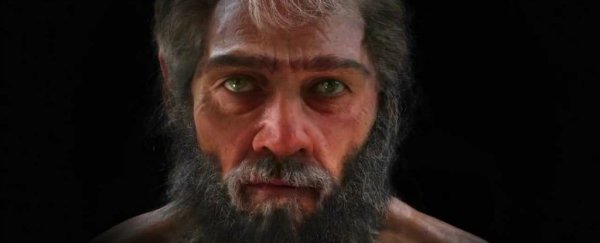We look in the mirror daily, but next time you catch a glimpse of your face, stop for a second and think about all the millions of years of evolution that have gone into shaping it. Seriously… just try to imagine it. It can be pretty mind-numbing, right? So to help you wrap your head around it a bit better, palaeo-artist John Gurche has created this 90-second time-lapse that takes you on a visual tour of just how far we've come as a species, focussing specifically on modern anglo-saxon faces.
The video was released back in 2013, and scientists have moved things around on the human family tree a little since then thanks to new discoveries, but these recreations and the impact they have is still very much as relevant as it was two years ago.
The journey starts with Sahelanthropus tchadensis, one of the oldest known human ancestors, which lived between 7 and 6 million years ago in West-Central Africa. The species is believed to have walked upright and had a combination of ape-like and human-like features.
We then morph our way through species such as Australopithecus afarensis (AKA Lucy), Homo heidelbergensis, and of course Homo neanderthalensis, with the faces slowly getting more 'human' as we progress. What's particularly striking is how certain facial features don't change, even over 7 million years. The modern humans selected by the artist in this time-lapse are of anglo-saxon heritage, so they don't represent the entire species, but they help you get the idea.
Gurche created these models of our ancestors' faces in collaboration with the Human Origins Program at the Smithsonian's Museum of Natural History, and has also released them in a book, Shaping Humanity. But they aren't just works of art, he collaborates very closely from the fossilised remains that have been found from each species to create the most accurate model possible.
"Usually the bones have something to say about how that particular species developed … Maybe there are strong muscle markings on the bones for flexor muscles of the head, of the hand and arm," Gruche told the Adam Wernick over at Science Friday back in 2014. "When you're doing this kind of work, you have to be aware of both the artistic side and the aesthetic side and also the scientific constraints you are operating under … You can't just make fantasy."
We're incredibly glad that there are artists out there willing to use their skills to bring art to life, because no matter how many peer-reviewed journal articles you read on human evolution, or fossils you look at, nothing hits home quite like seeing the human face change in front of your eyes.
"One might ask what the point is of reconstructing the bodies of these ancestral primates. Are the bones not enough?" Yale University Press wrote about Gurche's book. "There is a human fascination with making history come alive and feel real to us. Our past is more than just words on a page or the bare bones of a being; it's a consciousness that we try to tap into for us to enjoy, be inspired by, and learn from for the future."
We couldn't agree more.
H/t: Business Insider
